How to increase retail sales during peak shopping seasons
Learn how an improved marketing strategy and personalized interactions can increase retail sales when customer demand is at its highest.

Retailers invest resources, money, and effort into running holiday marketing campaigns to grab their audiences’ attention.
You could pick an average shopper off the street, ask them to open up their promotional folder in their inbox, and sift through hundreds of retail marketing messages, most of which are probably unopened.
How can retailers stand out to potential customers among all the retail noise? Your marketing communication strategy will help you get there if carefully crafted and executed.
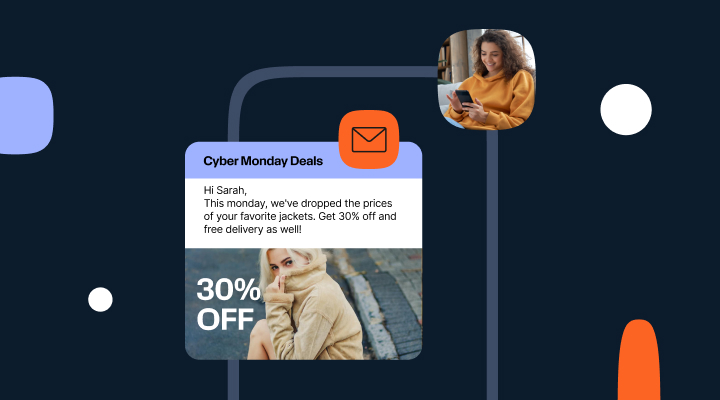
Let’s look at how retailers can build an innovative strategy to increase sales and drive better customer engagement.
Retail sales statistics for 2025
Understanding customers’ past behaviors and analyzing data is at the core of creating a good strategy. Let’s break down some need-to-know statistics for retailers to remember when crafting their marketing strategies.
Online retail sales
- 2.77 billion people shop online, expected to rise to 2.86 billion by 2026
- 52% of online shoppers look for products internationally
- 34% of shoppers buy online at least once a week
- 99% of customers check reviews before purchasing online
- China leads online shopping with 904.6 million shoppers, followed by the US with 288.45 million
- Global eCommerce sales projected to reach $6.86 trillion in 2025, up 8.37% from 2024
- 28 million eCommerce sites exist worldwide, a 2.9% increase from last year (50% are in the US)
- 44% of shoppers start their journey via search results, 41% go directly to online stores
Customers are increasingly shopping online but still want to have in-store experiences. If you are a brick-and-mortar store, consider deploying a web shop or app if you haven’t already, while also focusing on strategies to increase foot traffic to your physical location.
Black Friday and Cyber Monday sales
The shopping season is hectic for both shoppers and retailers, but it’s also when customers are most likely to buy.
- Around 87.3 million people shopped online on Black Friday 2024
- 69% of Black Friday purchases were made on mobile devices (up from 68% in 2023)
- Cyber Monday 2024 sales hit $13.3 billion, up $0.9 billion from 2023
- 54.8% of Cyber Monday shoppers completed purchases on their mobile phones
Social media retail sales
- Facebook leads social commerce in the US, with 69.4 million shoppers expected in 2025 (about 20% of the population)
- Instagram is used by 47.5 million shoppers
- 18–34-year-olds are the most active buyers on social media
- 65+ shoppers are the least likely, with only about a quarter making purchases through social platforms
How retailers used the Infobip platform in 2024
Customers increasingly use their devices and social media to explore retail shops and browse products. That means retailers should be meeting customers where they are – on their devices.
In 2024, we analyzed over 530 billion B2C interactions on our platform and found a 33% increase in retail customer engagement compared to previous years. Businesses are using multiple channels to connect with their audiences, with 38% of interactions happening on SMS, 35% on email, 15% on mobile app messaging, and 11% on WhatsApp. Many brands with both physical and online stores are also leaning more heavily into digital sales.
Global shopping events like Black Friday and Cyber Monday, which started in the United States, are now gaining popularity in APAC and other Eastern markets, where retailers are adding their own local touch.
As competition grows, retailers need to rethink how they reach their customers. Sending blanket discounts over email is no longer enough to stand out. Instead, targeted, personalized, and well-timed digital communication is the key to improve retail marketing campaigns, especially during the busy holiday season, and ensuring customers feel valued at every interaction.
Who prefers getting updates on discounts and sales?
- Younger Millennials show the strongest preference for updates on discounts and sales, with 78% wanting these messages.
- Gen Z is less interested, at 55%, likely because many are still supported by parents.
- Gen X sits in the middle at 63%, reflecting their higher earning potential.
Marketing strategies and examples to increase retail sales
1. Start with data
Your retail marketing strategy must be data driven. Over the years, you’ve collected lots of customer data and most likely have data on holiday shopping habits. It’s time to unify that data in one place and examine customer behaviors and interests to create a rock-solid messaging strategy.
- Segment your customers based on their demographics, average order value, purchase frequency, and behavior to provide offers targeted to their needs
- Look into last year’s data to find out which products drove maximum sales
- Identify your most loyal customers and give them an exclusive offer or preview before opening it up to everyone else
2. Make it personal
To stand out, brands need to turn to targeted communication campaigns. With price slashing being the norm for the shopping season, personalized customer service and tailored messaging will help you stand out.
Know your customers, create tailor-made offers, build segmented campaigns, and be creative.
For example, if you’re an electronics brand, promote relevant high-range products to high-value customers. Use contextual information and address them by their first name to make it personal and strengthen the emotional connection.
3. Run engagement campaigns
To engage your customers, run targeted messaging campaigns across your digital channels, including email, WhatsApp, Viber, SMS, RCS, and any other preferred channel. From welcoming new customers to reminding existing customers of an abandoned cart, ensure you have all your engagement campaigns set up.
- Notify customers about offers, such as free shipping, next-day delivery, or click-and-collect options (speed up the buying process)
- Remind customers about the return process and offer an extended return period
- Offer loyalty programs with increasing discounts or exclusive access to sales
- Ensure campaigns also highlight your point of sale benefits and encourage customers to visit both online and offline stores
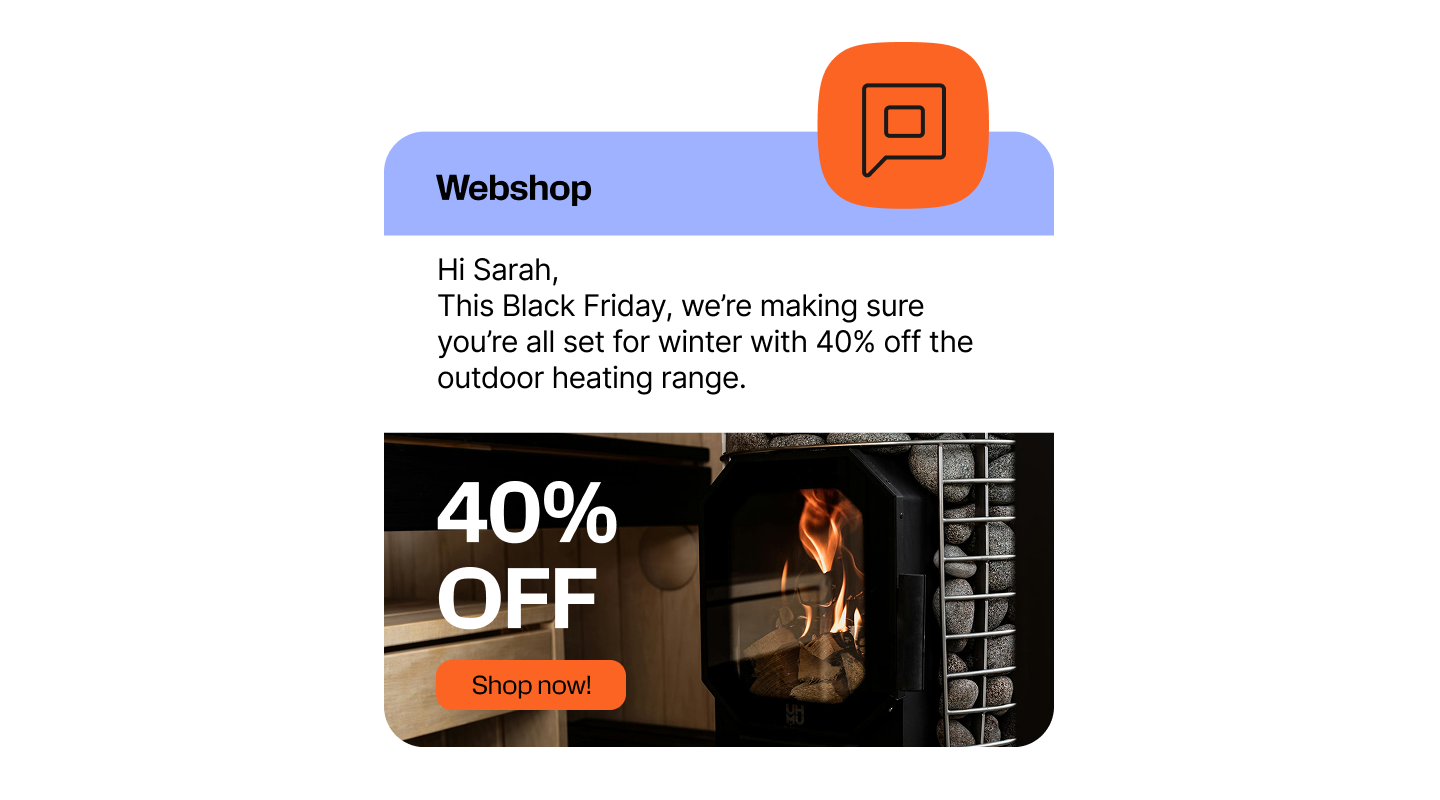
4. Setup your website and app
Any retailer aims to have high and steady traffic to their web shop. This traffic can drastically increase during the holiday season, which means your website and app must be ready to take on the traffic and enhance the shopping experience and product knowledge in a scalable manner Remember, creating a seamless experience can boost your conversion rate.
- Provide a seamless checkout for all mobile and website users with a secure payment gateway to boost conversion rates and add consistency along all devices
- Setup automated campaigns that lead customers straight to your webshop or app to complete purchases
- Add price alerts for specific products or categories before they go on sale for customers with your app
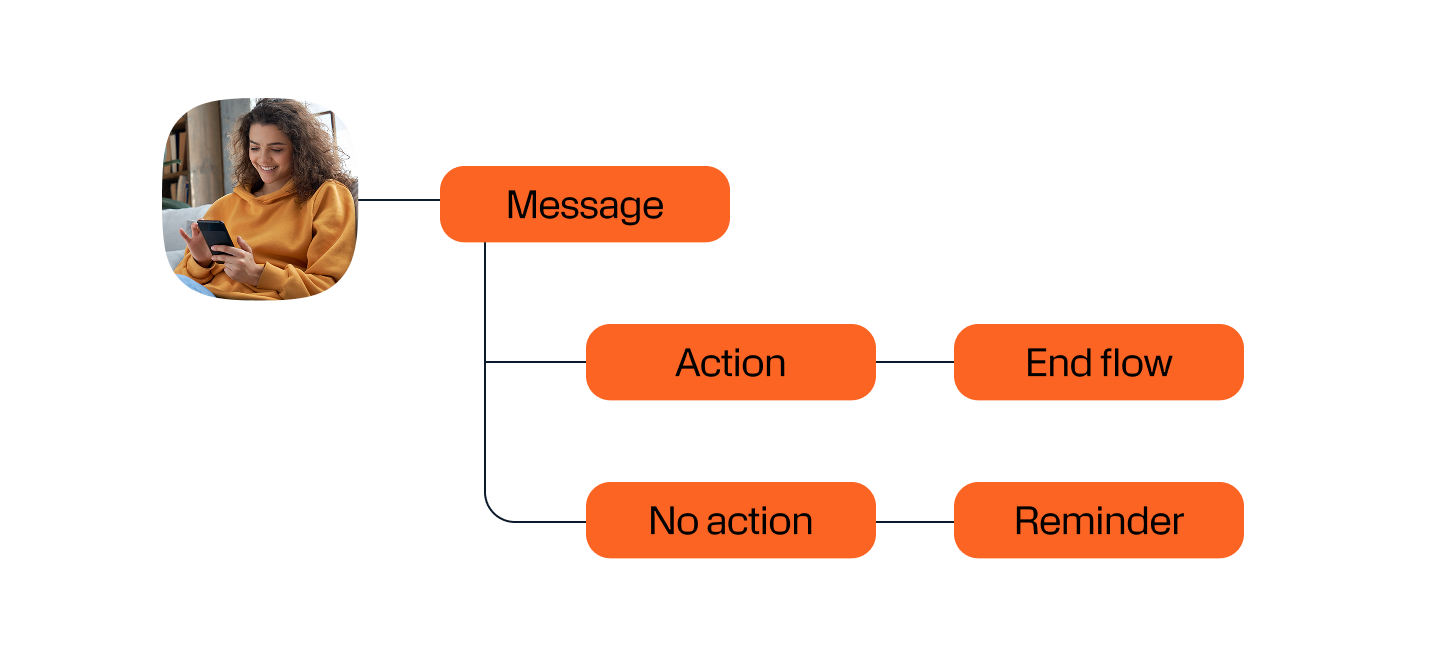
5. Prepare for delivery and returns
Nothing is more frustrating than a failed delivery or a complicated return process. A good customer experience for returns could encourage customers to shop with you again. Marketing yourself as a smooth operator for deliveries and returns and fulfilling your promises is essential.
- Offer 24/7 support with a chatbot that can inform customers on the ETA of their deliveries or return
- Use digital tracking to keep customers in the loop in real time and not wondering where their package is
- Set automated reminders to remind customers closer to the return date in case they wish to return the order and avoid disappointment
- Offer complimentary and paid services such as gift wrapping or assembly to improve the experience
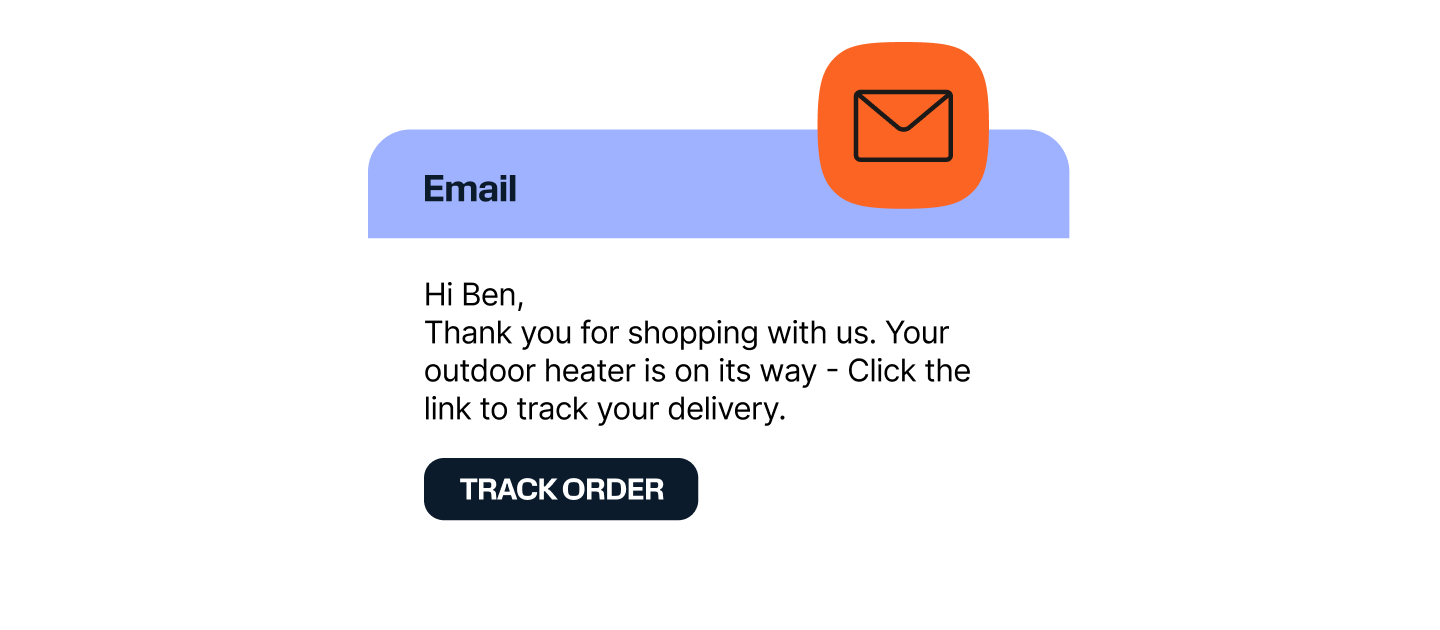
6. Campaign to retain customers
Once the shopping season is over, your customer engagement doesn’t end there. It’s time to boost loyalty and retain new customers. Many customers look for the best deal during the shopping season and are likely to be enticed by discounts.
Build on this and incentivize new customers by:
- Encouraging them to take specific actions, like a 10% discount if they leave feedback
- A personalized message on an item they were interested in but is out of stock
- A chance to have access to loyal customer privileges by making another purchase
Retail marketing campaign examples
Shopping season can mean many popular items are out-of-stock, but that doesn’t mean sales need to slow down. Try building an automated back-in-stock campaign to ensure customers remember items on their wish list or in their carts. It’s a great and simple way to boost sales and ensure the busy season extends well past the new year.
1. Send back-in-stock alerts as items hit your warehouse
When your new shipment arrives and the item is back in stock, alert customers waiting for that item. The product availability reminder must be specific and concise, with a call to action to encourage your customer to pick up where they left off.
Sending these alerts on the right channel changes how customers will act. Here are a few popular channels that can help you make sure customers see your back-in-stock updates and act on them:
SMS: With 90% of people opening SMS messages within 3 minutes, it’s a great way to send alerts and ensure they are seen. Customers can follow a hyperlink to your website and add the back-in-stock item to their cart.
WhatsApp: 86% of customers will pay more for better experiences, and you can offer them a seamless experience with WhatsApp. Send back-in-stock messages over this popular channel to ensure customers see the alert and provide easy ability to order the item instantly within the chat app conversation.
These messages remind the customer of items on their wish list. They also show that you understand how they want to communicate with you and add value to your interactions.
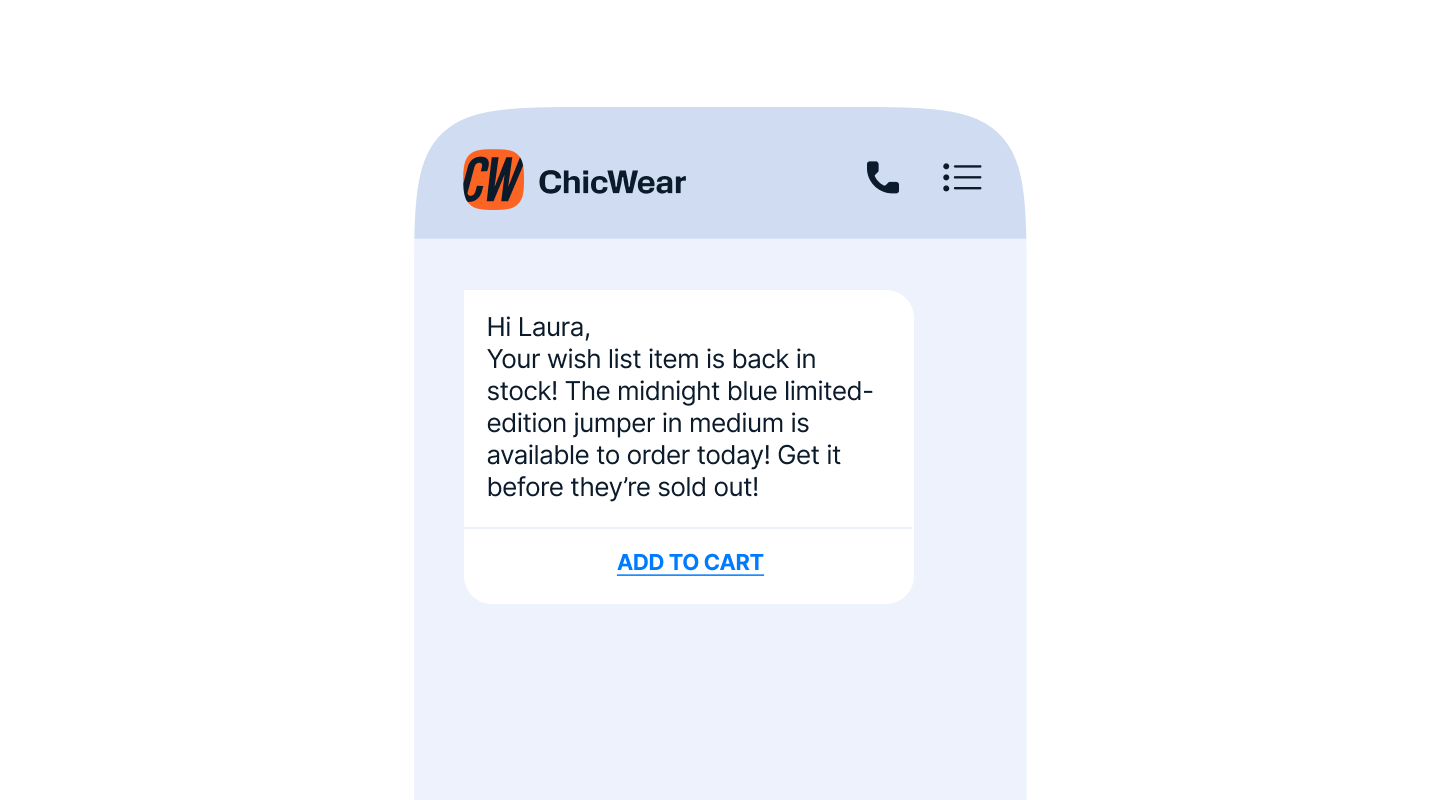
2. Allow customers to hold items by replying
Your customers are constantly on the go. Ensure you offer services that work around their busy lives during the holidays. When items they love are back-in-stock, allow them to reserve the item until they are ready to purchase by replying to your message.
Try using varying channels to get customers’ attention for these back-in-stock or low-in-stock items. Send an initial email or SMS to notify them, and then if they do not act, send a follow-up message on WhatsApp or Viber. Convey a sense of urgency and increase the likelihood of them completing the purchase. You will reach them through their preferred channel and secure a contact point for future communications.
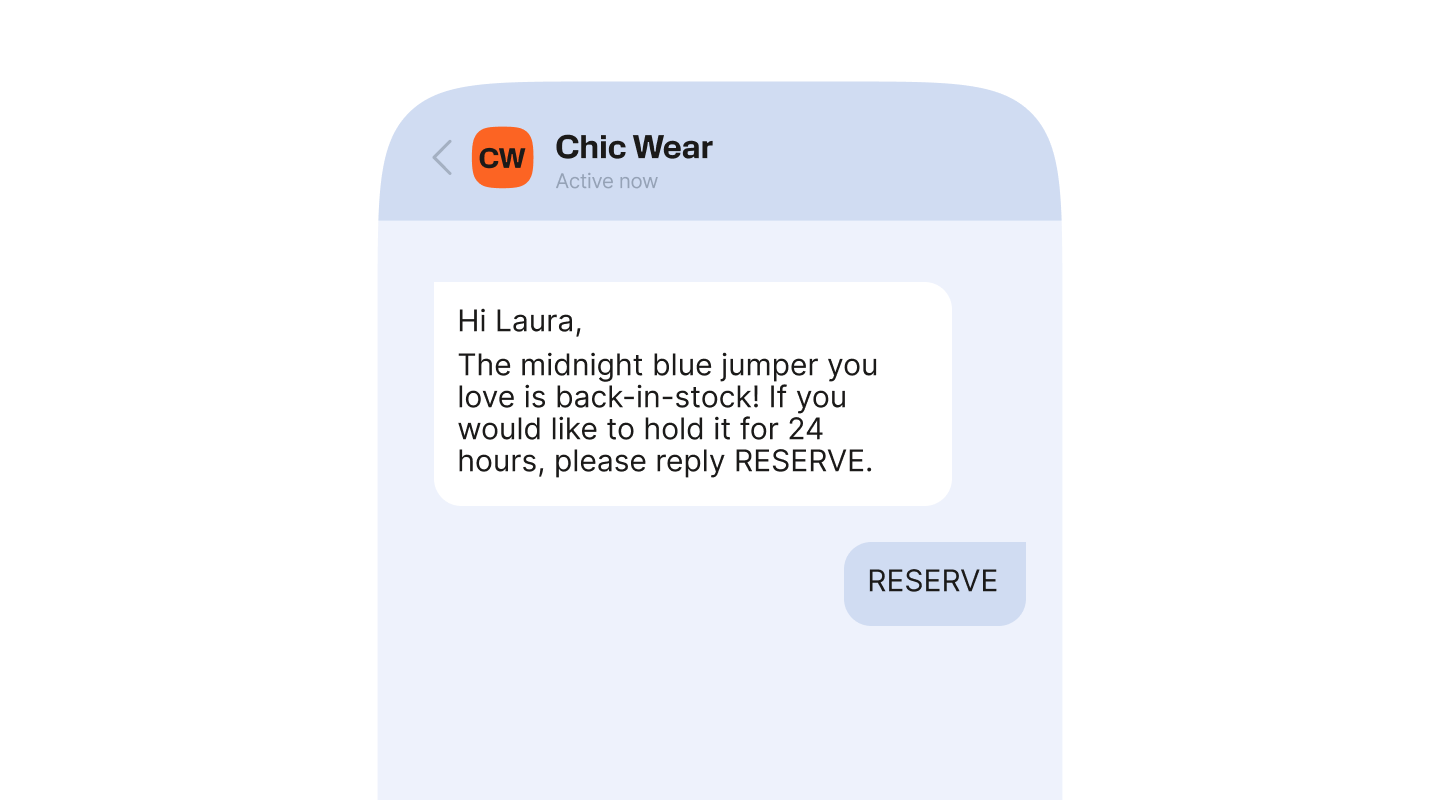
3. Send links to purchase other items you carry
Let your customer know the items they flagged won’t be restocked before the holidays. Use the opportunity to showcase alternative items in stock that address their needs. Be very specific with your suggestions for other options:
- Suggest items under the same brand, competitor, or previous versions
- Suggest the same or similar items in a different style, color, or brand
- List items that other customers purchased instead of the first choice
Use chat apps or Rich Communication Services (RCS) to send images and videos to customers to showcase the items. You will add greater value to messages by adding visuals, and your interactions will lead to higher conversions.
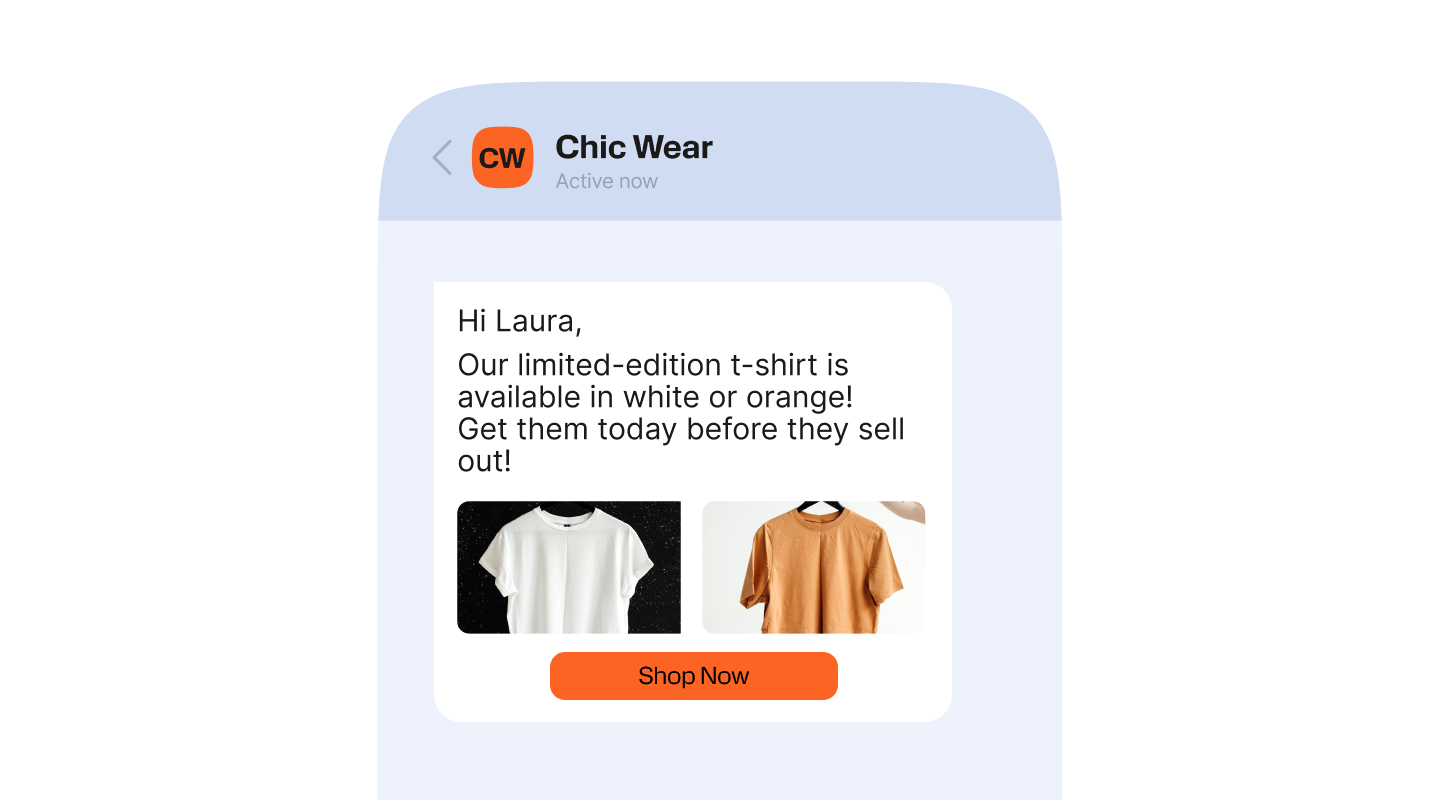
4. Follow up with a discount
If you won’t be able to get the item back in stock, send a discount code for another item in your store. You can tie the discount code into the alternatives you suggested in previous messages or offer exclusive personalized discount code.
Personalization is more than showing you know their first name. Analyze behaviors and past purchases to send relevant discounts and promotions they are more likely to act on. You could use geo-targeting features to entice customers to visit your local store. Send them push notifications near your location to let them know about a sale or special offers.
Sending these messages on WhatsApp, Viber, Messenger, SMS will make their customer experience as seamless as possible and help ensure your engagement converts to sales.
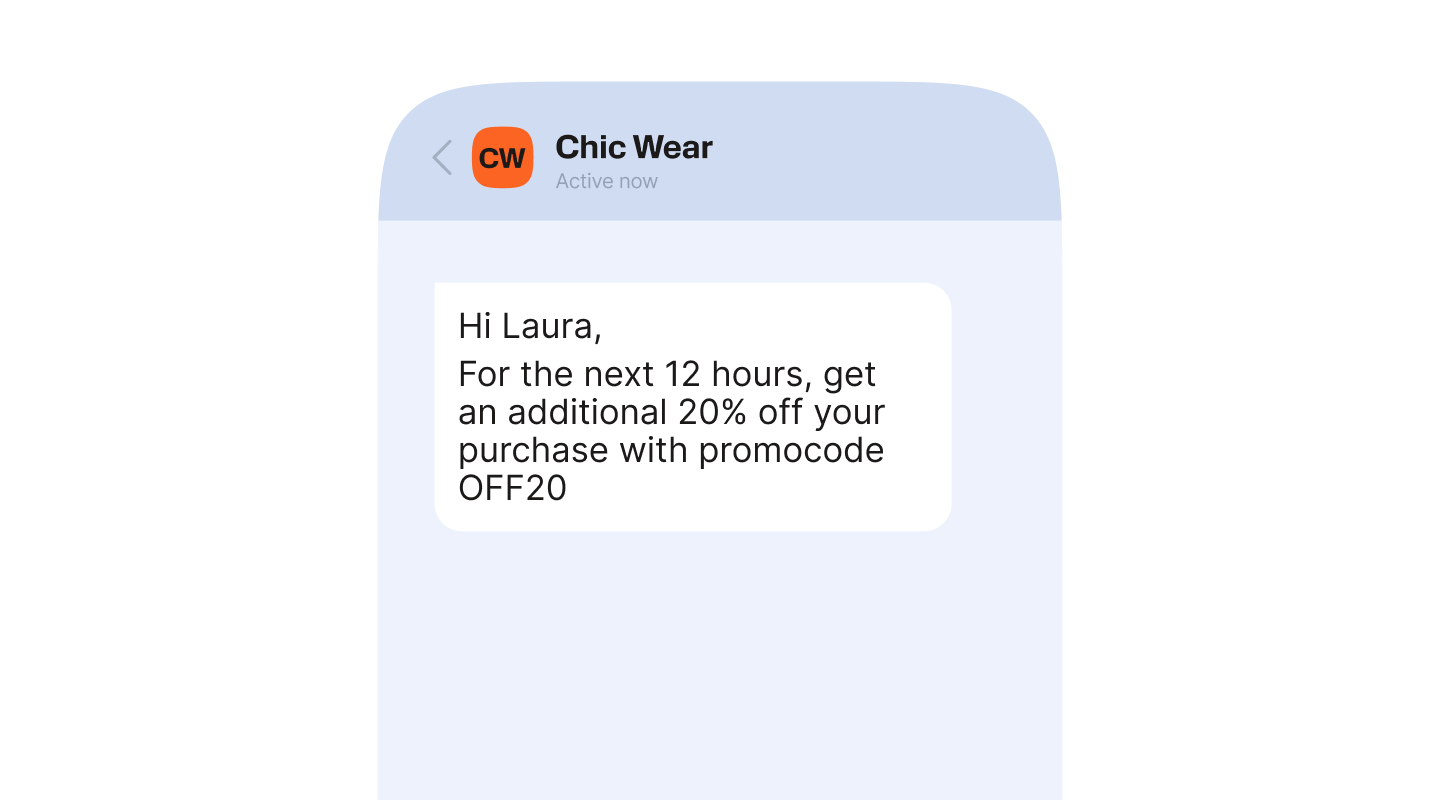
Continued success after the holidays
Having a data-driven and relevant marketing strategy prepared will help your retail business get the most out of the holiday shopping season. But don’t stop there. Retaining your holiday shoppers is a goal every retailer should have in order to improve their bottom line all year round.
Utilizing these tips and creating a solid marketing plan for this shopping season is just the beginning. Connect with your customers using personalized messaging over their favorite channels to continue the success all year round.








